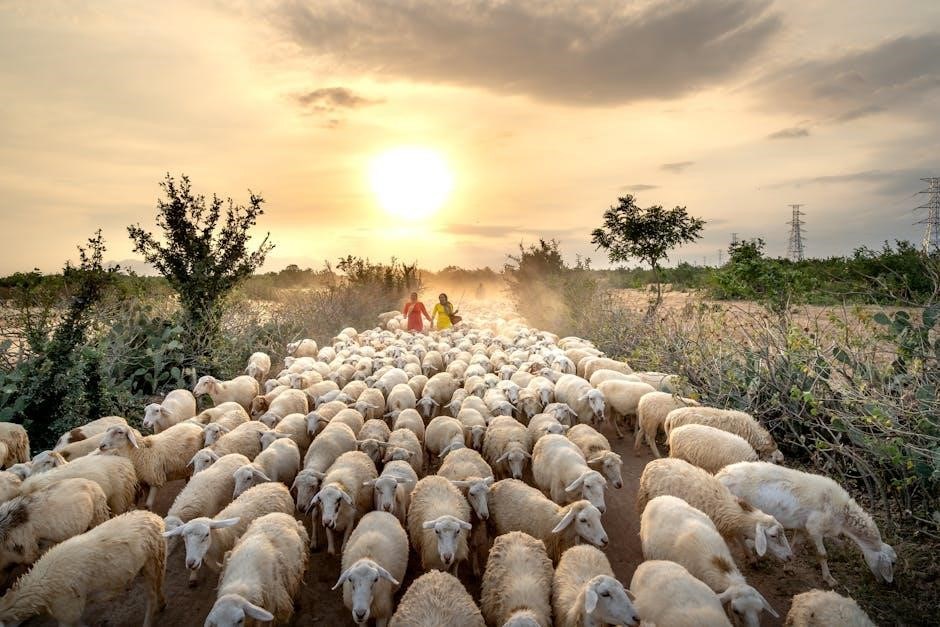Welcome to the diverse world of Michigan’s tree species! Explore the state’s rich forest ecosystems, featuring over 100 native species, each with unique characteristics for easy identification․
Overview of Michigan’s Forest Ecosystem
Michigan’s forest ecosystem is a vibrant mosaic of diverse tree species, shaped by its unique geography and climate․ The state’s two peninsulas support a wide range of habitats, from the coniferous forests of the Upper Peninsula to the deciduous woodlands of the Lower Peninsula․ Wetlands and aquatic environments further add to the ecological diversity, fostering a variety of tree species adapted to different conditions․ Dominant species like Largetooth Aspen and Paper Birch thrive in these environments, while others, such as American Basswood and Northern White Cedar, occupy specialized niches․ This rich biodiversity creates a dynamic ecosystem that supports wildlife and provides essential natural resources․
The balance of natural regeneration and managed forestry ensures the sustainability of Michigan’s forests, making them a vital part of the state’s ecological and economic heritage․
Importance of Tree Identification in Michigan
Accurate tree identification in Michigan is crucial for environmental conservation, forestry management, and ecological balance․ Identifying tree species helps in understanding their roles within ecosystems, ensuring sustainable practices, and preserving biodiversity․ It aids in combating invasive species and diseases, protecting native habitats․ Additionally, tree identification supports education and research, fostering a deeper connection with nature․ For enthusiasts and professionals alike, it enhances appreciation of Michigan’s forests while promoting responsible stewardship of natural resources․ By learning to identify trees, individuals contribute to the state’s environmental health and heritage․
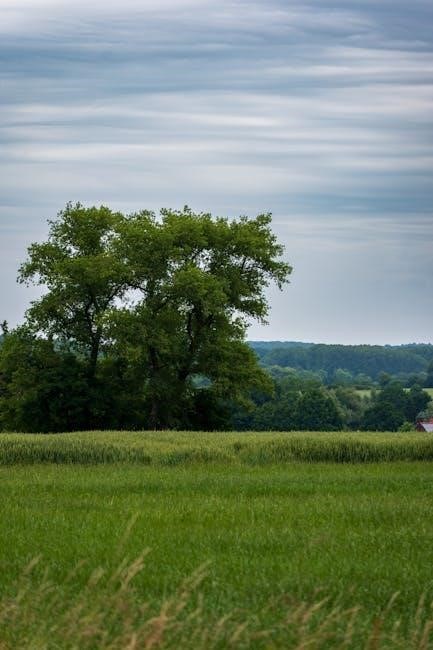
How to Use This Field Guide
Start by observing leaf type and attachment, then use thumb tabs to navigate․ Compare features like bark, seeds, and twigs for accurate identification of Michigan’s 105 tree species․
Organizational Structure: Leaf Type and Attachment
This guide organizes trees by leaf type and attachment, simplifying identification․ Each section focuses on specific traits, such as leaf shape, size, and how they attach to branches․ By categorizing trees this way, users can quickly narrow down species based on observable characteristics․ The structure ensures efficiency, making it easier for both beginners and experts to locate information․ Detailed descriptions and visuals aid in distinguishing similar species, ensuring accurate identification․ This method highlights the importance of leaves in tree recognition, providing a clear pathway for learners to explore Michigan’s diverse tree species effectively․
Key Features for Easy Identification
Identifying Michigan trees is made straightforward by focusing on key features such as leaf shape, size, and arrangement․ Leaf type, whether simple or compound, and how leaves attach to branches are critical starting points․ Bark patterns, twig textures, and the presence of buds or flowers also provide essential clues․ Seasonal changes, like the appearance of fruits or seeds, further aid in accurate identification․ By comparing these characteristics with detailed descriptions and visuals, users can confidently determine species․ This guide emphasizes these features, ensuring a user-friendly experience for both novices and experienced naturalists․ The combination of visual aids and clear descriptions makes tree identification accessible and efficient for everyone․
Using Visual Aids and Descriptions
Visual aids and detailed descriptions are indispensable tools for accurate tree identification․ High-quality images of leaves, bark, and fruits provide clear comparisons, while written descriptions highlight distinguishing features․ This guide’s organization by leaf type and attachment simplifies the process, allowing users to quickly narrow down species․ Thumbtabs and compare features enable side-by-side analysis, making identification intuitive․ The combination of visuals and text ensures that even subtle differences are noticeable, helping to avoid common mistakes․ Whether you’re a novice or an experienced observer, these resources make identifying Michigan’s trees both efficient and enjoyable, ensuring a deeper connection with the state’s diverse forest ecosystems․
Tree Identification Basics
Mastering tree identification involves observing leaf characteristics, bark patterns, and fruit types․ These features, along with twig structures, provide essential clues for accurately naming Michigan’s diverse tree species․
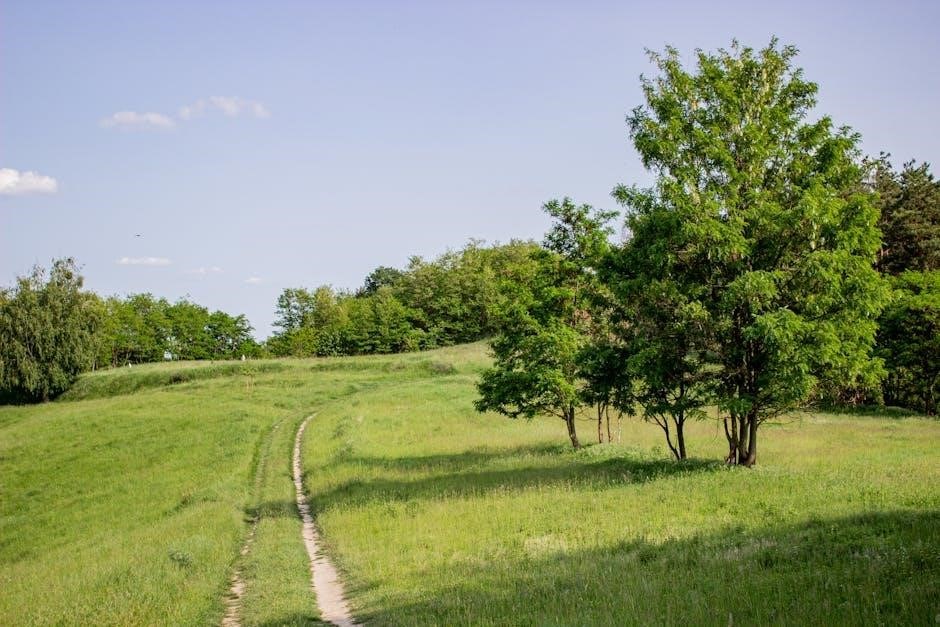
Leaf Characteristics: Shape, Size, and Arrangement
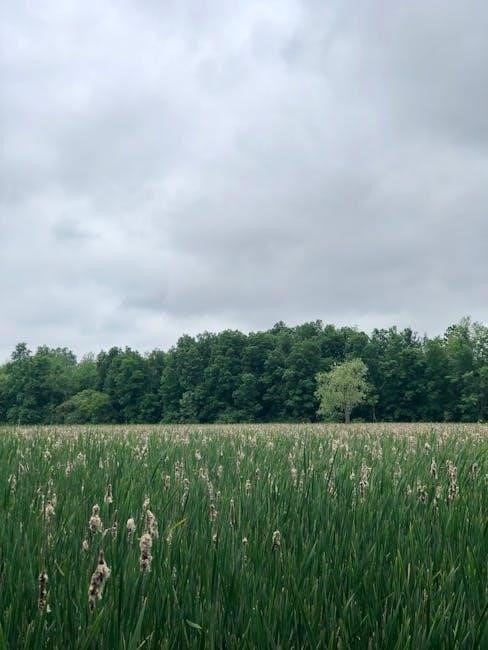
Leaf characteristics are fundamental for identifying Michigan’s tree species․ Leaves vary in shape, size, and arrangement, providing crucial clues․ Simple leaves, like those of oaks, are single-bladed, while compound leaves, such as walnuts, are divided into leaflets․ Size ranges from small, like hawthorn, to large, like bigleaf magnolia․ Arrangement refers to how leaves attach to twigs—alternate, opposite, or whorled․ These traits, along with venation patterns and margins, help distinguish species․ For example, maple leaves often have lobed margins, while birch leaves are typically doubly serrated; Observing these details and comparing them to field guides simplifies identification, making leaf study a cornerstone of tree recognition in Michigan․
Bark and Twig Features
Bark and twig features are essential for identifying Michigan’s trees, especially during winter when leaves are absent․ Bark patterns vary significantly, from the papery, white layers of paper birch to the thick, furrowed bark of ancient oaks․ Twigs reveal important details like color, texture, and the presence of buds or bud scales․ For example, the smooth, gray twigs of American beech contrast with the hairy, brown twigs of hazelnut․ Pith color inside twigs also aids identification, such as the chambered pith of elderberry․ These characteristics, combined with leaf and fruit traits, provide a comprehensive approach to tree recognition, making bark and twig analysis a vital skill for field guide users exploring Michigan’s forests․
Flowers, Fruits, and Seeds
Flowers, fruits, and seeds are crucial for identifying Michigan’s trees, offering distinct characteristics that complement leaf and bark features․ Many species produce showy flowers, such as the catkins of birch or the fragrant blooms of basswood․ Fruits vary widely, from the nutlets of alder to the acorns of oak, each with unique shapes and sizes․ Seeds often provide additional clues, like the winged samaras of maple or the needle-like seeds of pine․ These reproductive structures are especially useful for identification during flowering or fruiting seasons․ By examining these traits, field guide users can accurately distinguish between species, enhancing their understanding of Michigan’s diverse tree populations and their life cycles․
Common Michigan Trees
Michigan’s forests are home to iconic species like Largetooth Aspen, American Basswood, American Beech, and Paper Birch, each playing vital roles in the state’s ecosystems and culture․
Largetooth Aspen (Populus grandidentata)
The Largetooth Aspen is a striking deciduous tree native to Michigan, known for its vibrant foliage and distinctive leaf structure․ It thrives in moist to well-drained soils and open areas, often forming colonies․ The tree’s leaves are large, heart-shaped, and coarsely toothed, with a bright green hue that turns golden yellow in fall․ Reaching heights of up to 50 feet, the Largetooth Aspen is easily recognizable by its smooth, grayish bark and slender branches․ Its leaves quiver in the slightest breeze, creating a unique sound․ This species plays a vital role in Michigan’s ecosystems, supporting wildlife and offering beautiful scenery․ It is a popular subject in field guides for its notable characteristics and widespread presence across the state․
American Basswood (Tilia americana)
The American Basswood is a deciduous tree native to Michigan, renowned for its large, heart-shaped leaves with coarse teeth and a smooth base․ It can grow up to 60 feet tall, featuring a broad, rounded canopy and gray, furrowed bark․ Often found in moist, rich soils in woodlands and along streams, this tree thrives in shaded environments․ Its leaves are bright green during summer and turn pale yellow in fall․ Small, fragrant flowers appear in late spring, followed by clusters of small, nut-like fruits․ A valuable ecological asset, the American Basswood supports pollinators and wildlife, making it a significant species in Michigan’s forests․ Its size and distinctive leaves make it easily identifiable in the field․
American Beech (Fagus grandifolia)
The American Beech is a striking deciduous tree native to Michigan, known for its smooth, slate-gray bark that remains unchanged with age․ It reaches heights of 50 to 70 feet, with a stately, upright growth habit and a dense canopy․ Its dark green, wavy-edged leaves are oval-shaped with a pointed tip, turning a golden-bronze color in fall․ Preferring shaded, moist environments, the American Beech thrives in rich soils and is often found in climax forests․ It produces small, edible triangular nuts enclosed in spiny husks, which are vital for wildlife․ This tree is celebrated for its longevity and ecological importance, playing a key role in maintaining forest diversity and providing habitat for various species․ Its distinctive bark and persistent leaves make it a standout in Michigan’s woodlands․
Paper Birch (Betula papyrifera)
The Paper Birch, also known as the Canoe Birch, is one of Michigan’s most recognizable trees due to its striking white, papery bark․ It grows up to 50-70 feet tall, with a slender profile and a rounded crown․ Native to cooler climates, it thrives in well-drained soils and full sun to partial shade․ Its leaves are dark green, ovate, and doubly toothed, turning yellow in fall․ The bark, which peels horizontally, is its most distinctive feature․ Paper Birch is highly valued for its ornamental appeal and historical use by Native Americans for crafting canoes․ It also provides food for wildlife, making it a vital part of Michigan’s ecosystems․ This tree is a symbol of resilience and beauty in the state’s forests․
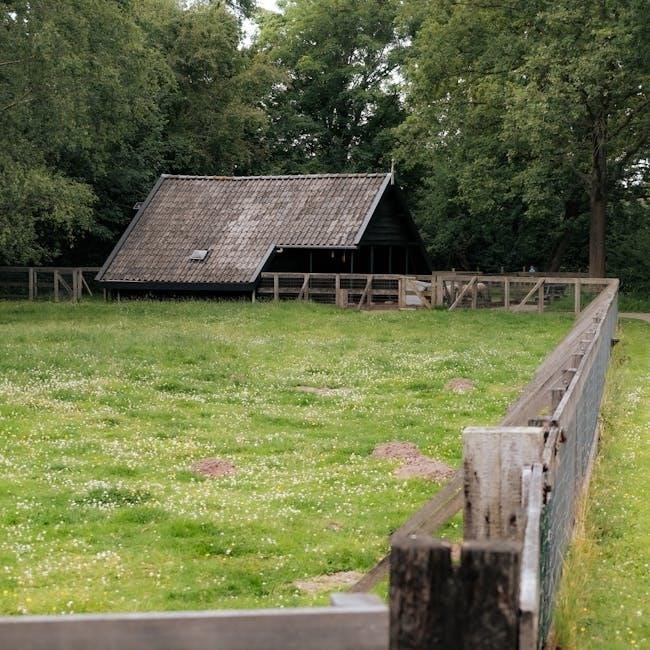
Less Common but Significant Trees
Michigan is home to several less common but ecologically significant tree species, such as Northern White Cedar, Wild Black Cherry, American Chestnut, and Eastern Cottonwood․ These trees, though not as abundant, offer unique characteristics and contributions to the state’s diverse ecosystems․
Northern White Cedar (Thuja occidentalis)
The Northern White Cedar, also known as Thuja occidentalis, is a native evergreen tree in Michigan, often found in wetlands and along shorelines․ It is highly aromatic, with scale-like leaves that form fan-shaped branches․ The tree produces small, oblong cones and has reddish-brown bark that peels in thin strips․ Known for its durability, Northern White Cedar is resistant to rot and insects, making it ideal for outdoor construction․ It grows relatively slowly and prefers moist, acidic soils․ This tree is valued for its distinctive appearance and is commonly used in landscaping for hedges and ornamental purposes․ Its wood is also prized for building fences and boats due to its natural resistance to decay․ Northern White Cedar is a significant species in Michigan’s ecosystems, providing habitat for various wildlife․
Wild Black Cherry (Prunus serotina)
Wild Black Cherry (Prunus serotina) is a significant tree species in Michigan, known for its dark, shiny leaves that are elliptical in shape․ It produces clusters of small, white flowers in the spring, which later develop into black berries that are a favorite food source for various wildlife․ The tree’s reddish-brown bark features horizontal lenticels, adding to its ornamental appeal․ Wild Black Cherry is also valued for its wood, which is highly prized in furniture-making due to its rich color and fine grain․ This tree thrives in well-drained soils and can be found in both woodland areas and along roadsides, making it a common and familiar sight throughout the state․
American Chestnut (Castanea dentata)
The American Chestnut (Castanea dentata) is a historically significant tree in Michigan, once thriving in the state’s forests before being devastated by the chestnut blight․ This large deciduous tree can grow up to 100 feet tall, with a broad, spreading canopy and dark, furrowed bark․ Its leaves are long, toothed, and lance-shaped, providing shade and sustenance for wildlife․ The tree produces edible chestnuts, a vital food source for animals and humans alike․ However, the chestnut blight has nearly eradicated mature trees, leaving mostly stumps and sprouts․ Conservation efforts are underway to restore this iconic species, which holds cultural and ecological importance in Michigan’s forests․
Eastern Cottonwood (Populus deltoides)
The Eastern Cottonwood (Populus deltoides) is a large, fast-growing deciduous tree native to Michigan․ It thrives in wetlands, riverbanks, and open areas, often reaching heights of 50 to 100 feet․ Its broad, spreading canopy and thick, deeply furrowed bark make it a striking sight․ The leaves are triangular with a flattened base, turning golden-yellow in autumn․ Eastern Cottonwood is known for its cotton-like seeds, which disperse widely in the wind․ This tree plays a vital role in ecosystems, providing habitat for wildlife and stabilizing soil along waterways․ Despite its rapid growth, it is relatively short-lived and often used for timber and pulpwood, making it a significant species in Michigan’s forests and wetlands․
Specialized Identification Guides
This section provides specialized techniques for identifying Michigan trees, focusing on leaf type, attachment, and additional features like leaf buds, twigs, flowers, and fruits for accurate classification․
Identifying Trees by Leaf Type
Leaf type is a key feature for identifying Michigan trees․ This guide organizes species by leaf characteristics, such as shape, size, and arrangement․ Trees are categorized into broad groups: alternate, opposite, and whorled․ Simple leaves, like those of oaks, and compound leaves, found in walnuts, are clearly distinguished․ Each leaf type is described in detail, with photos and descriptions to aid recognition․ For example, maple leaves are typically palmate, while pine needles grow in clusters․ This method simplifies identification, especially for beginners․ By focusing on leaf type, users can quickly narrow down species and make accurate identifications․ This approach ensures efficiency and accuracy in the field․
Identifying Trees by Bark and Twig Characteristics
Bark and twig features are crucial for identifying Michigan trees, especially during winter when leaves are absent․ Bark patterns vary significantly, from the paper-like peeling of Paper Birch to the deep furrows of American Beech․ Twig color, texture, and bud placement also provide vital clues․ For instance, Black Cherry twigs emit a distinctive odor when scraped․ By examining these traits, even novice identifiers can distinguish species accurately․ This method is particularly reliable in colder months, ensuring year-round identification․ Detailed descriptions and photos in field guides help users recognize these subtle yet distinctive features, making tree identification accessible and efficient for everyone․
Seasonal Variations in Tree Identification
Michigan’s trees display distinct seasonal changes, offering unique identification opportunities throughout the year․ In spring, budding patterns and flower emergence are key, while summer showcases leaf structure and arrangement․ Autumn brings vibrant foliage and seed production, such as the bright colors of Maple or the catkins of Aspen․ Winter highlights bark textures and twig features, as seen in the smooth, gray bark of Beech or the aromatic buds of Black Cherry․ These variations require a flexible approach, using different characteristics depending on the season․ Field guides tailored to Michigan’s climate help users adapt their strategies, ensuring accurate identification regardless of the time of year․ This seasonal awareness enhances the overall experience of exploring Michigan’s diverse tree species․
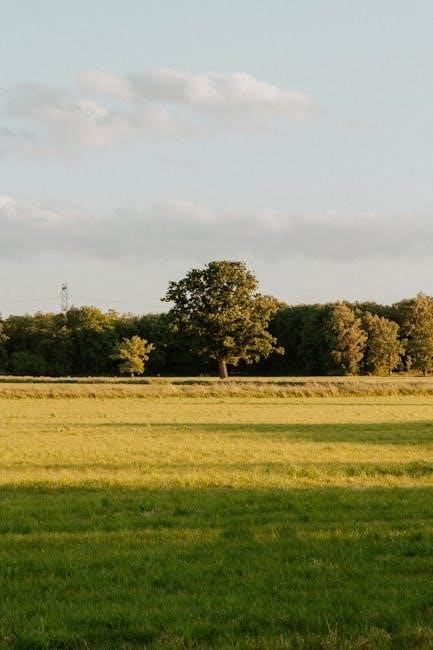
Michigan’s Native and Non-Native Trees
Michigan’s forests are home to a mix of native and non-native tree species․ Native trees like Eastern White Pine and Red Maple thrive in local ecosystems, while non-native species, such as Tree of Heaven, have been introduced and sometimes cause ecological disruption․ Understanding their origins and impacts is crucial for conservation efforts․
Native Tree Species of Michigan
Michigan boasts a rich variety of native tree species, each adapted to the state’s diverse climates and soil types․ Trees like the Paper Birch, Northern White Cedar, and American Beech are staples of Michigan’s forests․ These species have evolved over centuries to thrive in the region’s cool, moist environments․ Native trees play a crucial role in maintaining ecological balance, providing habitat for wildlife, and supporting local ecosystems․ They are also vital for timber production, recreational activities, and scenic beauty․ Understanding and preserving these native species is essential for maintaining Michigan’s forest health and biodiversity․ This guide highlights key characteristics of these trees, helping readers appreciate their importance and uniqueness․
Invasive and Non-Native Tree Species
Michigan’s forests are vulnerable to invasive and non-native tree species, which can disrupt ecosystems and harm native biodiversity․ Trees like the Emerald Ash Borer (affecting Ash species) and European Buckthorn have significantly impacted local flora․ These species often outcompete natives, altering habitats and reducing forest health․ Non-native trees such as Tree-of-Heaven and Autumn Olive are particularly invasive, spreading rapidly and degrading natural areas․ Early detection and management are critical to preventing further ecological damage․ This guide helps identify and differentiate invasive species from native trees, emphasizing the importance of conservation efforts to protect Michigan’s forest ecosystems․ By understanding these threats, readers can contribute to preserving the state’s natural heritage․
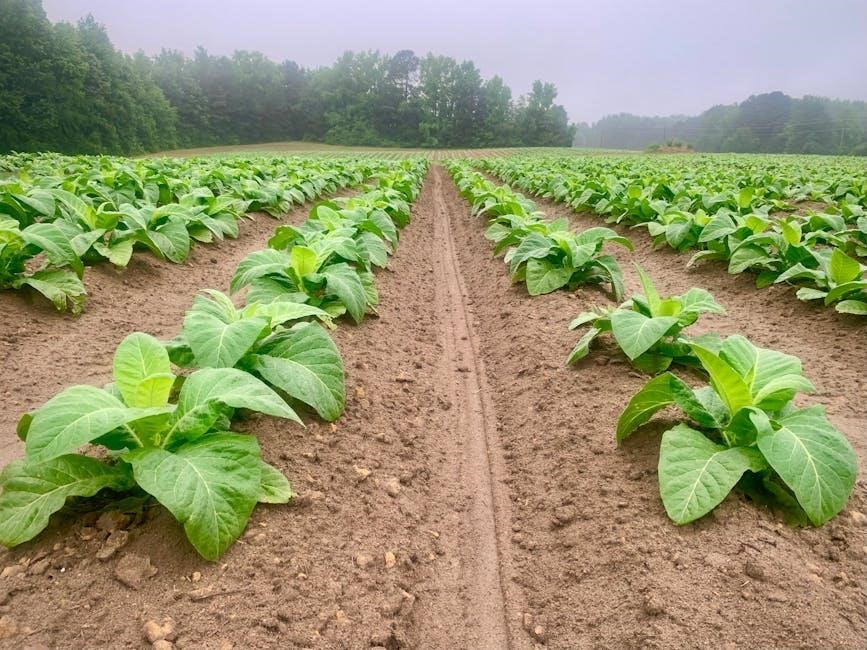
Michigan’s Forest Regions and Tree Habitats
Michigan’s forests span two peninsulas, with the Upper Peninsula dominated by northern species and the Lower Peninsula hosting mixed hardwoods and wetland trees, creating diverse habitats․
Upper Peninsula Tree Species
The Upper Peninsula of Michigan is home to a variety of tree species adapted to its cooler, harsher climate․ Dominant species include paper birch, quaking aspen, and balsam fir, which thrive in the region’s boreal forests․ Hardwoods like northern maple and yellow birch are also common, while conifers such as eastern spruce and northern pine populate the area’s dense woodlands․ The Upper Peninsula’s unique combination of wetlands and uplands supports species like black ash and tamarack, which are well-suited to the region’s moist environments․ These trees play a vital role in the local ecosystem, providing habitat for wildlife and contributing to the region’s natural beauty․ The diversity of tree species in the Upper Peninsula makes it a fascinating area for exploration and study․
Lower Peninsula Tree Species
The Lower Peninsula of Michigan boasts a rich diversity of tree species, including hardwoods and conifers․ Prominent species such as American basswood, American beech, and paper birch are widespread, while wild black cherry and eastern cottonwood thrive in the region’s fertile soils․ The area’s forests also feature northern red oak and white pine, which are highly valued for their timber and ecological roles․ Wetland species like northern white cedar and red maple are common in the peninsula’s swampy areas․ This variety of tree species contributes to the region’s vibrant ecosystems, supporting wildlife and offering scenic beauty․ The Trees of Michigan Field Guide provides detailed information on these species, making identification accessible for both enthusiasts and researchers․
Wetland and Aquatic Tree Species
Michigan’s wetlands and aquatic environments are home to a variety of tree species adapted to thrive in moist conditions․ Northern white cedar is a common sight in swamps and bogs, while red maple flourishes in wetlands and along riverbanks․ Black willow and river birch are also prevalent, tolerating periodic flooding and saturated soils․ These trees play a crucial role in stabilizing wetland ecosystems and providing habitat for diverse wildlife․ The Trees of Michigan Field Guide offers detailed descriptions of these species, highlighting their unique characteristics, such as bark patterns and leaf shapes, to aid in identification․ Exploring these aquatic and wetland species reveals the resilience and beauty of Michigan’s natural landscapes․ Each species contributes to the state’s ecological balance, making them vital components of wetland conservation efforts․
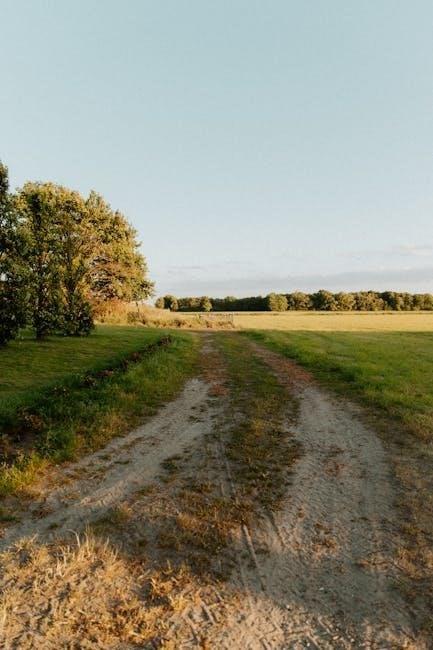
Conservation and Management
Maintaining Michigan’s tree populations requires proactive conservation and management strategies․ Efforts include reforestation, protecting native species, and combating invasive threats to ensure forest health and biodiversity․
Threats to Michigan’s Tree Populations
Metallics’s tree populations face significant threats, including invasive species, climate change, and forest diseases․ Invasive insects like the emerald ash borer have devastated ash tree populations, while diseases such as beech bark disease impact American beech trees․ Climate change exacerbates drought conditions and increases susceptibility to pests and pathogens․ Additionally, urbanization and logging contribute to habitat loss and fragmentation, further endangering native species․ These challenges highlight the urgent need for conservation efforts to protect Michigan’s forest biodiversity and ensure the survival of its iconic tree species for future generations․
Tree Planting and Conservation Efforts
Metallics’s commitment to tree planting and conservation is vital for maintaining its rich forest ecosystems․ Programs like the Michigan Tree Planting Initiative focus on restoring native species and reforestation efforts․ These initiatives aim to replenish areas affected by invasive species and disease outbreaks, promoting biodiversity․ Additionally, urban tree planting programs enhance green spaces, improving air quality and community well-being․ Conservation partnerships between government agencies, NGOs, and local communities play a crucial role in protecting Michigan’s tree populations․ These efforts ensure the preservation of its natural beauty and ecological balance for generations to come․
Thank you for exploring Michigan’s diverse tree species! This guide has provided essential tools for identification and appreciation․ Continue discovering and preserving Michigan’s natural beauty․
Final Thoughts on Michigan Tree Identification
Identifying Michigan’s trees is a rewarding journey that deepens your connection to nature․ With over 105 species documented, this guide simplifies the process, ensuring accessibility for all skill levels․ By focusing on leaf type, bark, and seasonal changes, you can confidently recognize even the lesser-known trees․ Conservation efforts are vital to protect these species, and understanding their roles in ecosystems fosters appreciation․ Whether you’re a seasoned naturalist or a curious beginner, this guide empowers you to explore Michigan’s forests with clarity and purpose․ Keep discovering, learning, and contributing to the preservation of these natural wonders for future generations․
Encouragement for Further Exploration
Exploring Michigan’s tree species is a lifelong journey of discovery․ With this guide, you’re equipped to venture into forests, parks, and even your backyard to identify and learn about the diverse flora․ Consider participating in local tree-planting events or joining conservation efforts to protect these vital ecosystems․ Seasonal changes offer new opportunities to observe trees in different stages, from spring blooms to autumn colors․ Share your findings with others, inspiring a greater appreciation for nature․ Whether you’re a student, hobbyist, or outdoor enthusiast, continued exploration will deepen your understanding and connection to Michigan’s natural beauty․ Keep exploring, learning, and growing your knowledge of these incredible trees!
